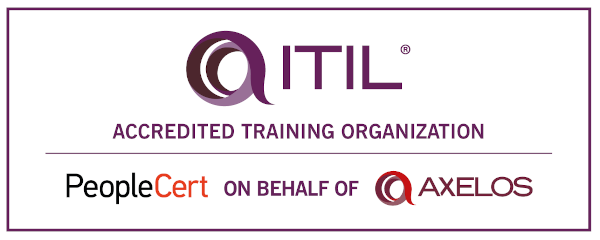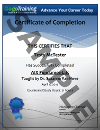Why GogoTraining's ITIL 4 Foundation Course is the Best!
GogoTraining's Accredited ITIL 4 Foundation course is delivered by Dr. Suzanne Van Hove. Dr. Van Hove is recognized by multiple leaders in the industry as a true IT Service Management thought leader and students think she is the best. Suzanne's courses bring tough concepts to life so you can understand and apply them when you take your certification exam and in real life. And Suzanne is available while you train to answer your questions.
When you purchase the ITIL 4 Foundation 1-Year Course & Exam Package for $795 you receive the following exclusive features:
- 1 Year Course Access -
- Free Course Extensions
- Course Instructor Available to Answer Questions
- 4.5 Hours of Video Lessons
- 17 Quizzes - Test your Knowledge as you Learn
- 2 AXELOS Official Sample Exams
- 1 PeopleCert Exam Voucher
- 1 PeopleCert Exam Retake (Take2)
- Official AXELOS eBook (Digital Copy)
- PeopleCert Course Support Materials
- Flexible Online Course Access so you can Train Anytime
In this course you will:
- Learn key IT service management concepts
- Understand the ITIL 4 service management framework
- Embrace new concepts like the Service Value System (SVS) and the Service Value Chain (SVC)
- Understand ITIL's 7 Guiding Principles
- Get an introduction to ITIL 4's Management Practices
Who Needs to Take ITIL 4 Foundation?
- Everyone who is ITIL V3 Foundation Certified
- Everyone who is new to ITIL getting ITIL Foundation Certified for the first time
- All ITIL V3 Certificate holders who want to understand what ITIL 4 covers in order to prepare their organizations to adopt and adapt ITIL 4 into their organization
What is ITIL 4?
ITIL 4 combines the best of ITIL 3 and expands it to include the key principals of Digital Transformation providing a larger systems application of ITIL into the enterprise. This brings ITIL into the fast-paced complex world we live in. ITIL 4 is designed to give organizations a comprehensive system for the management of information technology in our modern service economy. In so doing it covers the full delivery and sustenance of tech-enabled products and provides guiding tools to for the interface of IT into the wider business strategy.
BONUS VIDEOS
For students who are new to ITIL we have included a Bonus Video Section that provides background on ITIL V3 (2011). The ITIL V3 videos provide a solid foundation on ITIL and will help those new to ITIL in understanding ITIL 4. All students who purchase the ITIL 4 Foundation course will gain access to the bonus videos within 24 hours Monday to Friday. To View the Bonus Content, Click Here.
Prepare for Certification
This course is designed to prepare students to sit for the ITIL 4 Foundation Exam which leads to the internationally recognized ITIL 4 Foundation Certification. In this course you will receive video instruction by Dr. Van Hove, course materials, an exercise guide, sample exams, the syllabus and 1 year access to the course and Dr. Van Hove to ask questions.
Why Take ITIL 4 From GogoTraining?
GogoTraining is the leading on-demand education provider for ITIL Training. Our courses are Accredited by AXELOS and PeopleCert and taught by Industry Expert Dr. Suzanne Van Hove. Suzanne's accomplishments are noted below and when you take this course you receive direct access to Dr. Van Hove to ask questions. If you want to learn with the best, then Suzanne is the instructor for you.
- Suzanne has over 20 years experience in IT Service Management
- She was named as of the 2018 Top 25 Thought Leaders in the field - HDI Survey
- She is the Convenor for SC40/WG2 - the group that creates and maintains the ICO/IEC 20000 series of standards
- She is a lead author of VeriSM™
- Suzanne received itSMF USA's Lifetime Achievement Award
- She has trained over 10,000 students in ITIL, ISO 20000, COBIT 5 and VeriSM
- In addition to consulting and teaching courses for major corporations and institutions, Suzanne also teaches Service Management principles at several universities around the globe.
Module 00: Course Introduction: ITIL® 4 Foundation
- The Nature of the Class
- Agenda
- AXELOS ITIL 4 Schema
- Available Resources
Module 01: Exam Tips
- Understanding the Exam Process
- Exam Questions and Grading
- Taking the Exam
- Using the Practice Exams
Module 02: High-Level Service Management & Key Elements of ITIL 4
- Where are Services and Service Management Today?
- Introduction to the Key Elements of ITIL 4:
- Service Value System (SVS)
- Four Dimensions Model
Module 03: ITIL 4 Key Concepts
- 15 Terms
- Practical Application
- Axel Car Hire
Module 04: Service - Definition & Keys Features
- What is a Service?
- Service Provision
- Service Offering
- Service Relationship Management
- Organizational Service Management
Module 05: Service Offerings & Relationship
- Goods
- Provisioning
- Consumption
Module 06: Putting it All Together
- Example
Module 07: The Service Relationship Model
Module 08: Axel Car Hire Example
- Value
- Value Co-Creation
- Utility
- Warranty
- Cost
- Outcome
- Output
- Risk
Module 09: Critically of Value
- Utility
- Warranty
Module 10: The Dimensions of Service Management
- Overview of the Four Dimensions
- Organizations & People
- Information & Technology
- Partners & Suppliers
- Value Streams & Processes
- Organization & People
- Culture
Module 11: Key Features of Information & Technology
- The Changing Role of Technology
- The Value of Technology
- The Importance of Data
Module 12: Partners & Suppliers
- Making it All Work
- Partners & Suppliers
- Contracts and Agreements
Module 13: Value Streams and Processes
- The Service Value System
- The Service Value Chain
- Value Streams
- Processes
Module 14: Introduction to ITIL’s Service Value System (SVS)
The Objectives
The Purpose
Overview
Module 15: Service Value System Components
- Governance
- Practices
- Service Value Chain
- The Impact of a Poor SVS
Module 16: Overview of ITIL’s Service Value Chain (SVS)
- Value Chain Activities
- What’s included, What’s not
- Triggers
- Service value Streams
- Key Exam Tip
Module 17: Service Value Chain – Plan
- The Purpose
- What’s Included
Module 18: Service Value Chain – Improve
- The Purpose
- What’s Included
Module 19: Service Value Chain – Engage
- The Purpose
- What’s Included
Module 20: Service Value Chain – Design & Transition
Module 21: Service Value Chain – Obtain/Build & Deliver & Support
- The Purpose
- What’s Included
Module 22: ITIL’s 7 Guiding Principles
- What They Do
- How They Help
- What They Are
- Exam Tip
- Focus on Value
Module 23: Start Where You Are
- Definition
- How it Works
Module 24: Progress Iteratively with Feedback
- Definition
- Application
- Collaborate & Promote Visibility
- Definition
- Application
- Agile, Lean & DevOps
Module 25: Think and Work Holistically
- Definition
- Implications
- Keep it Simple and Practical
- Why Simple is Important
- Practical Solutions
Module 26: Optimize & Automate
- Technology VS. Human Oversight
- Benefits of Automation
Module 27: Introduction to Key ITIL Practices
- Introduce the Concept of a “Practice”
- Introduce the Three Groups of ITIL Practices
- General Management
- Service Management
- Technical Management
Module 28: General Management Practices
- Purpose Statements
- Information Security Management
- Relationship Management
- Supplier Management
Module 29: Continual Improvement
- The Purpose
- The Scope
- Key Activities
- Methods and Models
- Approaches – Lean, Agile, DevOps
Module 30: The Continual Improvement Model
- What Does it Say?
- How it Works
Module 31: Continual Improvement & Guiding Principles
- The Details
- Collaborate & Promote Visibility
Module 32: Service Management Practices (SMP)
- Discuss the Purpose of:
- IT Asset Management
- Monitoring and Event Management
- Release Management
- Service Configuration Management
Module 33: Service Management Practices - Change Control
- The Definition
- The Importance of Change Enablement
- Emergency Change
Module 34: Service Management Practices - Incident Management
- The Definition
- The Purpose
- The Process
Module 35: Service Management Practices - Problem Management
- The Purpose
- The Definition
- Phases
Module 36: Service Management Practices - Service Requests Management
- The Definition
- The Purpose
- Types of Requests
- Guidelines
Module 37: Service Management Practices - The Service Desk
- The Purpose
- The Function
- Practical Application
Module 38: Service Level Management (SLM)
- The Purpose
- The Definition
- Skills and Competencies
Module 39: Information Analysis for Service Level Management
- The Process
- Information Sources
Module 40: Technical Management Practices
- Discuss the Purpose of:
- Deployment Management
- Review the Discussed ITIL Practices
Module 41: Conclusion
- Review Exam Content
- Final Thoughts on Taking the Exam
There are no prerequisites to take the ITIL 4 Foundation Course.
View all course details


